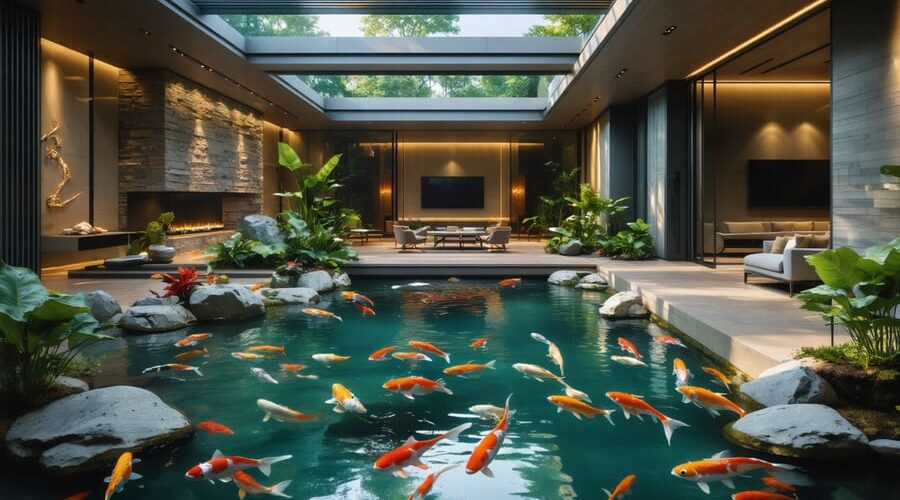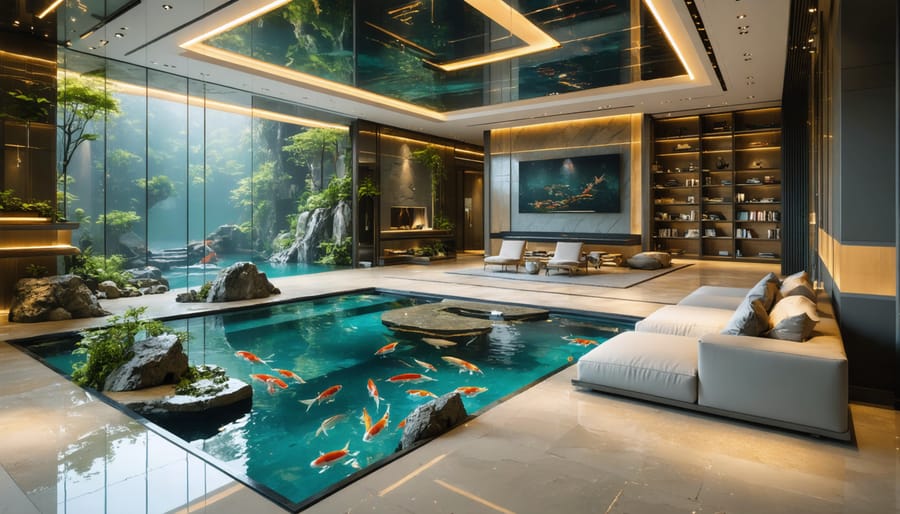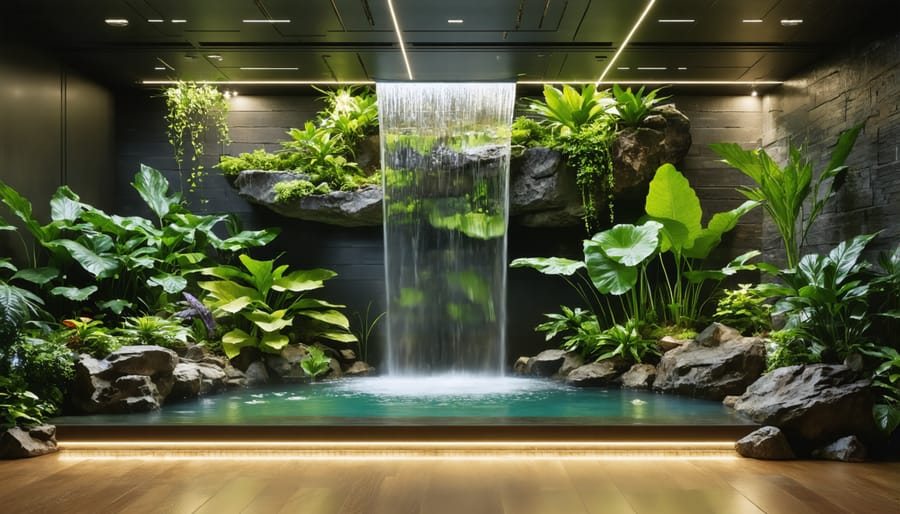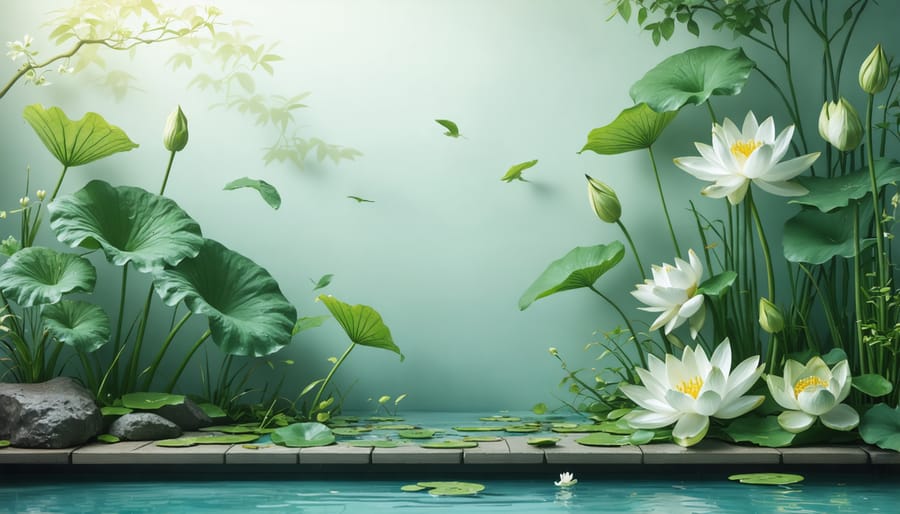
Transform Your Living Space with a Breathtaking Indoor Pond
Transform your living space into a serene sanctuary with an indoor pond – nature’s most captivating home feature. Imagine the gentle sound of flowing water echoing through your rooms, creating a peaceful atmosphere that instantly melts away daily stress. Indoor ponds aren’t just stunning focal points; they’re living ecosystems that bring the therapeutic benefits of water gardens right into your home.
From sleek modern designs incorporated into minimalist living rooms to rustic natural pools nestled in sunrooms, indoor ponds offer endless possibilities for creative expression and biophilic design. These water features can be scaled to fit any space, whether you’re considering a small meditation corner with a bamboo fountain or dreaming of a grand koi pond beneath a skylight.
Beyond their aesthetic appeal, indoor ponds naturally humidify your air, create perfect conditions for tropical plants, and provide a unique opportunity to keep aquatic pets in an environment where you can enjoy them year-round. With proper planning and maintenance, these indoor oases become living art pieces that evolve and grow with your home.
Let’s explore how you can bring this slice of nature indoors, creating a sustainable ecosystem that serves as both a stunning design element and a source of daily joy and tranquility.
Why Bring a Pond Inside Your Home?
Creating a Natural Oasis
An indoor pond transforms your living space into a serene natural sanctuary, bringing the calming essence of water features right into your home. The gentle sound of flowing water creates a meditative atmosphere that helps reduce stress and anxiety while purifying the air around you. By incorporating aquatic plants, smooth stones, and ambient lighting, you can craft a living ecosystem that connects you with nature throughout the year.
The presence of water adds humidity to your indoor environment, benefiting both you and your houseplants during dry winter months. Choose plants like water lilies, lotus, and marsh grasses to add layers of natural beauty and create a self-sustaining miniature wetland. Fish like koi or goldfish bring movement and life to your indoor oasis, making it a fascinating focal point for family and guests.
Consider placing your indoor pond near a meditation corner or reading nook to maximize its therapeutic benefits. The interplay of light on water creates mesmerizing reflections that dance across your walls, adding a dynamic element to your home’s ambiance while fostering a deeper connection with the natural world.
Year-Round Water Feature Benefits
An indoor pond offers unique advantages that outdoor water features simply can’t match. Protected from harsh weather conditions, your indoor water feature maintains consistent water temperatures year-round, creating a stable environment for both plants and fish. You’ll never need to worry about winterizing your pond or protecting delicate aquatic plants from frost damage.
The controlled indoor environment also means less maintenance overall. Without falling leaves, debris, or extreme temperature fluctuations to contend with, water quality remains more stable. You can enjoy crystal-clear water and healthy aquatic life with minimal effort. The consistent indoor climate also reduces water evaporation, meaning fewer top-offs and more stable water chemistry.
Perhaps best of all, you can enjoy your water feature regardless of the weather outside. Imagine relaxing to the sound of flowing water during a winter storm, or watching your fish swim peacefully as rain pounds against your windows. An indoor pond transforms any room into a year-round oasis, providing a constant connection to nature and a peaceful retreat within your home.
Popular Indoor Pond Designs
Sunken Floor Ponds
Sunken floor ponds create a seamless integration between your living space and water feature, offering a unique perspective as you walk alongside the water’s surface. These innovative installations follow many of the same koi pond design considerations, but require careful structural planning to ensure your home’s foundation remains protected.
The installation process typically involves excavating the floor, installing proper waterproofing membranes, and creating a reinforced concrete shell. A viewing window can be incorporated into the design, allowing you to observe aquatic life from basement rooms or lower levels. Many homeowners opt to add LED lighting around the edges, creating a stunning nighttime display that reflects off the ceiling.
Safety is paramount with sunken ponds, so incorporate non-slip materials around the edges and consider installing clear acrylic barriers that maintain visibility while preventing accidents. The depth can be customized to your needs, though most indoor sunken ponds range from 2 to 4 feet deep to accommodate various fish species and aquatic plants while maintaining manageable maintenance requirements.

Raised Feature Ponds
Raised feature ponds add a striking architectural element to your indoor space while making water gardening more accessible. These elevated designs can serve as room dividers, focal points, or even creative window features. By raising the pond above floor level, you create a more intimate connection with the water feature, allowing you to observe fish and aquatic plants from a comfortable viewing height.
Popular materials for raised ponds include glass, acrylic, and masonry construction, each offering unique aesthetic possibilities. Glass panels provide a contemporary look and allow viewing from multiple angles, while stone or brick structures create a more traditional feel. Enhance your raised pond’s appeal with cascading waterfalls, floating fountains, and LED lighting options that create mesmerizing reflections on your walls and ceiling.
Consider incorporating built-in seating around your raised pond or integrating it with existing furniture arrangements. The elevated design also makes maintenance easier, as you won’t need to bend down for routine care. Just ensure your floor structure can support the weight of water and materials before installation.

Glass-Walled Pond Features
Glass walls and viewing windows transform an indoor pond from a simple water feature into a mesmerizing living art piece. These transparent panels offer unique glimpses into the underwater world, allowing you to observe fish, plants, and aquatic life from multiple angles. Popular options include acrylic or tempered glass panels that can be installed along walkways, beneath floor sections, or as room dividers.
For the best viewing experience, consider installing LED lighting around the glass panels to illuminate the underwater scene. Strategic placement of rocks, plants, and other decorative elements near the glass creates depth and visual interest. Many homeowners choose to incorporate viewing windows at different heights, from floor-level peek-holes perfect for children to eye-level panels that serve as stunning focal points in living spaces.
Remember that glass walls require regular cleaning and maintenance to keep views crystal clear. Using automated cleaning systems and choosing the right glass thickness for your pond’s size will ensure long-lasting enjoyment of your underwater display.
Essential Construction Considerations
Structural Requirements
Creating an indoor pond requires careful attention to structural requirements to ensure both safety and longevity. Your floor must be capable of supporting significant weight – water weighs approximately 8.3 pounds per gallon, plus the weight of materials like liner, rocks, and decorative elements. For a typical 6×8 foot pond that’s 2 feet deep, you’ll need support for roughly 2,000 pounds.
Start by having a professional assess your floor joists and foundation. Basement or ground-floor installations are ideal, as they provide direct support from the earth below. If installing on upper floors, additional support beams or reinforcement may be necessary.
Waterproofing is equally crucial. Install a high-quality rubber or PVC liner with a protective underlayment to prevent leaks. Pay special attention to sealing around any pipes or filtration equipment. Create a slight slope toward the drain area to prevent water from pooling around the edges. Consider installing moisture barriers in surrounding walls and applying waterproof sealant to nearby surfaces.
Always include an overflow system and leak detection sensors as extra safety measures. These precautions help protect your home’s structure from potential water damage.
Ventilation and Humidity Control
Proper ventilation is crucial when maintaining an indoor pond to prevent excess moisture from damaging your home. Install a quality ventilation system that includes both intake and exhaust fans to create proper air circulation around your pond area. This helps control humidity levels and prevents condensation from forming on walls and windows.
Consider using a dehumidifier near your pond, especially in smaller rooms or spaces with limited natural airflow. Monitor humidity levels using a hygrometer, aiming to maintain them between 40-60%. This range is comfortable for both humans and aquatic life while preventing moisture-related issues like mold growth or peeling wallpaper.
Strategic placement of fans can help move air across the water’s surface, reducing stagnation and excessive humidity. During warmer months, you might need to increase ventilation to compensate for higher evaporation rates. In winter, be mindful of heating systems, as they can create dry conditions that increase evaporation.
Install moisture-resistant materials around your pond area, such as water-resistant paint or tile. Regular maintenance of your ventilation system, including cleaning fans and checking filters, ensures optimal performance and helps protect your home’s structure while maintaining a healthy environment for your indoor water feature.
Filtration and Maintenance Access
Proper equipment placement and accessibility are crucial for maintaining a healthy indoor pond ecosystem. When designing your indoor pond, create dedicated spaces for filtration systems for indoor ponds that are both effective and easily accessible. Consider installing access panels or removable sections in the surrounding structure to reach pumps, filters, and other equipment without disrupting the entire setup.
A smart approach is to design a maintenance zone that’s concealed yet convenient. This could be behind decorative panels, beneath floating deck sections, or integrated into nearby cabinetry. Understanding the maintenance requirements for water features will help you plan these access points effectively.
Remember to include adequate electrical outlets near your maintenance areas and ensure proper ventilation for equipment. Installing quick-disconnect fittings for pumps and filters makes routine maintenance much easier. Consider creating a small storage area nearby for testing kits, cleaning supplies, and spare parts.
For larger indoor ponds, incorporate stepping stones or platforms that allow you to reach different areas of the pond safely. This thoughtful planning will save you time and effort in the long run while keeping your indoor pond looking its best.
Bringing Your Indoor Pond to Life
Indoor-Friendly Aquatic Plants
When it comes to bringing life to your indoor pond, several aquatic plants thrive beautifully in indoor conditions. Water lilies are perfect centerpieces, with dwarf varieties like Nymphaea ‘Pygmaea Helvola’ being particularly well-suited for indoor spaces. Their floating leaves and stunning blooms create an elegant display without overwhelming your pond.
Lucky bamboo and peace lilies are excellent choices for the pond’s edges, as they can grow with their roots submerged while adding vertical interest. For oxygenating plants, consider hornwort or anacharis, which help maintain water quality and create a healthy ecosystem for any fish you might add.
Floating plants like water lettuce and duckweed are easy to maintain and provide excellent surface coverage. They help reduce algae growth by limiting light penetration and add a lush, natural feel to your indoor water feature.
For a touch of color and texture, consider incorporating marsh marigolds or Japanese rush along the pond’s margins. These plants adapt well to indoor conditions and provide year-round interest. Remember to choose plants that match your pond’s size and depth – smaller ponds work best with compact varieties that won’t outgrow their space.
Most importantly, all these plants can thrive in normal room temperatures and don’t require special lighting beyond what’s typically available in well-lit indoor spaces.

Choosing the Right Fish
Selecting the right fish for your indoor pond is crucial for creating a thriving aquatic ecosystem. Goldfish are perfect starter fish, particularly fancy varieties like Orandas and Fantails, as they adapt well to indoor environments and don’t require huge spaces. These elegant swimmers add vibrant colors and stay relatively small, making them ideal for most indoor setups.
For those with larger indoor ponds, consider including Koi carp. While beautiful, remember that Koi grow quite large and need at least 250 gallons of water per fish. They’re also social creatures, so plan on keeping several together for their well-being.
Smaller alternatives include White Cloud Mountain Minnows and Zebra Danios, which are hardy and active fish that bring life to your indoor water feature. These species are particularly suitable for temperature-controlled environments and can coexist peacefully with other small fish.
When stocking your pond, follow the general rule of one inch of fish per gallon of water. This helps maintain water quality and ensures your fish have enough space to thrive. Regular feeding schedules, water quality monitoring, and proper filtration are essential for keeping your aquatic pets healthy.
Remember to introduce fish gradually to their new environment and avoid overfeeding, which can lead to water quality issues. Start with a small group and add more over time as your pond ecosystem stabilizes.
Creating an indoor pond is more than just a home improvement project – it’s an investment in your well-being and living space that brings nature’s tranquility right into your home. As we’ve explored throughout this guide, indoor ponds offer countless benefits, from improved air quality and humidity control to creating a stunning focal point that transforms any room into a peaceful sanctuary.
Remember that success lies in careful planning and attention to detail. Start small if you’re new to water features, and don’t hesitate to seek expert advice when needed. Consider your space carefully, choose appropriate materials and equipment, and select plants and fish that will thrive in your indoor environment.
Maintenance doesn’t have to be overwhelming when you establish good routines from the start. Regular water testing, filter cleaning, and plant care will keep your pond healthy and beautiful year-round. The joy of watching your ecosystem develop and flourish will make these small tasks worthwhile.
Ready to begin your indoor pond journey? Start by measuring your space and sketching out your design ideas. Gather inspiration from nature and existing indoor ponds, but don’t be afraid to add your personal touch. With proper planning and care, your indoor pond will become a cherished feature of your home, providing years of enjoyment and a unique connection to nature.
Take that first step today – your indoor oasis awaits!
